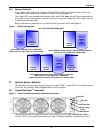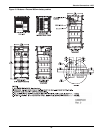
Electrical Connections—UPS
19
3.2.5 Cabling Guidelines
The following are guidelines only and are superseded by local regulations and codes of practice where
applicable. Use wiring rated at 75°C or greater.
1. Take special care when determining the size of the neutral cable, as current circulating on the
neutral cable may be greater than nominal current in the case of non-linear loads. Refer to the
values in 11.4 - UPS Electrical Characteristics.
2. The ground conductor should be sized according to such factors as the fault rating, cable lengths
and type of protection. The ground cable connecting the UPS to the main ground system must
follow the most direct route possible. Control wiring and power wiring must be run in separate
conduit. Output and input cables must be run in separate conduit.
3. Consider using paralleled smaller cables for heavy currents—this can ease installation.
4. When sizing battery cables, a maximum voltage drop of 4VDC is permissible at the current
ratings in Table 43. For terminal connection sizing, see Tables 41 through 43.
5. In most installations, the load equipment is connected to a distribution network of individually
protected busbars fed by the UPS output, rather than connected directly to the UPS itself. When
this is the case, the UPS output cables can be rated to suit the individual distribution network
demands rather than being fully load-rated.
6. When laying power cables, do not form coils; this will help avoid increasing formation of
electromagnetic interference.
NOTE
If more load is added to the distribution panel, the unit’s cabling must be resized.
NOTE
Right-side access may be required when making power connections. Cable connections should
be made before a cabinet is attached to the right side of the Liebert
®
APM
™
or before the UPS is
placed where another obstruction, such as a wall, is against the Liebert APM’s the right side.


















